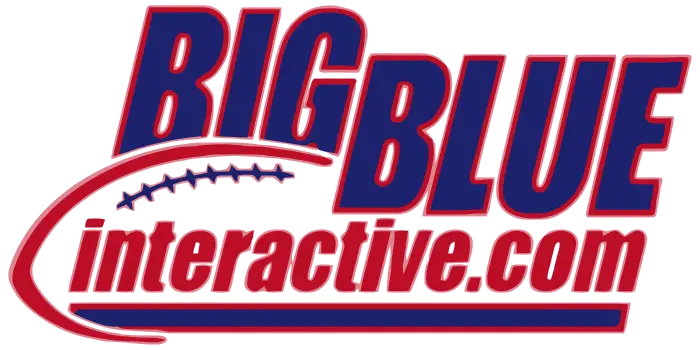(Updated August 15, 2021)
1925 – 1936: Basic Beginnings
A fact obscured by history is that the New York Football Giants were anything but the “Big Blue” Giants we root for today. Red was the team’s primary color for the majority of their first 31 years in the NFL, including their entire residence at The Polo Grounds.
When the Giants took the field in Providence on October 11, 1925 to face the Steamrollers, they wore an outfit that looked nothing like the modern uniform system worn by football players today. Most teams in 1925 looked very similar with unadorned brown leather helmets and baggy, tan or beige pants that included hip pads high above the waist. The only distinguishing elements between opponents in this era were the team colors displayed on the jerseys and socks. The Giants wore red bodied jerseys that featured dark royal blue shoulders and a matching blue band around the body, and large white block numbers on the back. The socks were red with the blue band trimmed by white stripes. Midway through the season the brown helmets were replaced with white helmets. This uniform set was the Giants primary look (save for some minor modifications) for the majority of their first eight seasons, including their first NFL Championship in 1927.
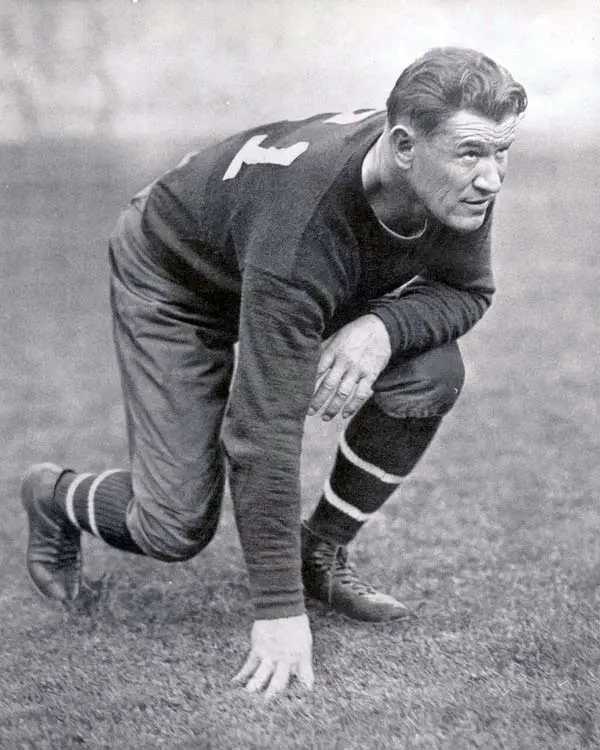
Jim Thorpe wore #21 for the 1925 Giants
Some significant changes were made in 1929. The white helmets were replaced by brown, and white block numbers were added to the front of the blue-banded red jerseys. Also, an alternate uniform was used for some road games. After acquiring the Detroit Wolverines franchise to secure star player Benny Friedman, their uniforms were incorporated in varying combinations with the Giants existing uniforms. The Wolverine’s jersey was solid blue on the front and sleeves, with a contrasting white back with blue block numbers and oval leather side patches. The socks were blue on the bottom and white on top.
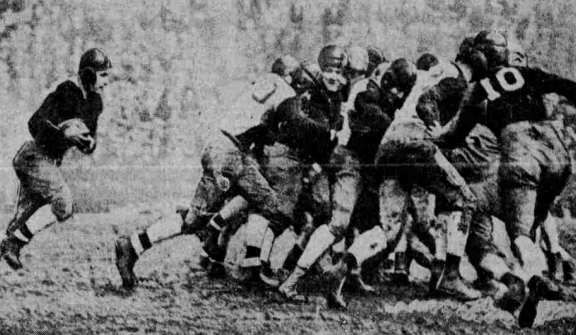
The Giants two-toned jerseys worn for away games in 1929 & 1930.
The Wolverine jersey was discontinued after the 1930 season, the same year the Giants introduced a new red helmet with a blue bumper on front and cross pattern over the crown. In 1932 a new jersey was added to the ensemble. Similar to the current jersey, this one had a lighter royal blue band around the body, and it was trimmed by white stripes. Small white block numbers were centered front and back of the blue band. This uniform was worn for all home games, the older uniforms were featured at occasional away games. An additional helmet appeared in 1933 that was worn concurrently with the existing helmet. The news one featured a blue shell with eight red stripes covering the crown (sometimes called “spider stripes”).
The Giants won their second NFL Championship in 1934 in brand new uniforms. Their first major uniform overhaul was a drastic departure from what had been their consistent general design. White helmets with a red bumper were worn for most games, but for the season opening game at Detroit, the Giants donned red helmets with blue bumpers. The jersey bodies remained red, but the blue horizontal bands were replaced by white vertical stripes from the shoulders down the length of the sleeves, and royal blue side panels. The collars of the jerseys were royal blue, and the small white block numbers had a royal blue boarder. The pants no longer had the high hip pads, but did have red stripes down the back of the legs. The red socks had blue and white stripes lower down the calf.
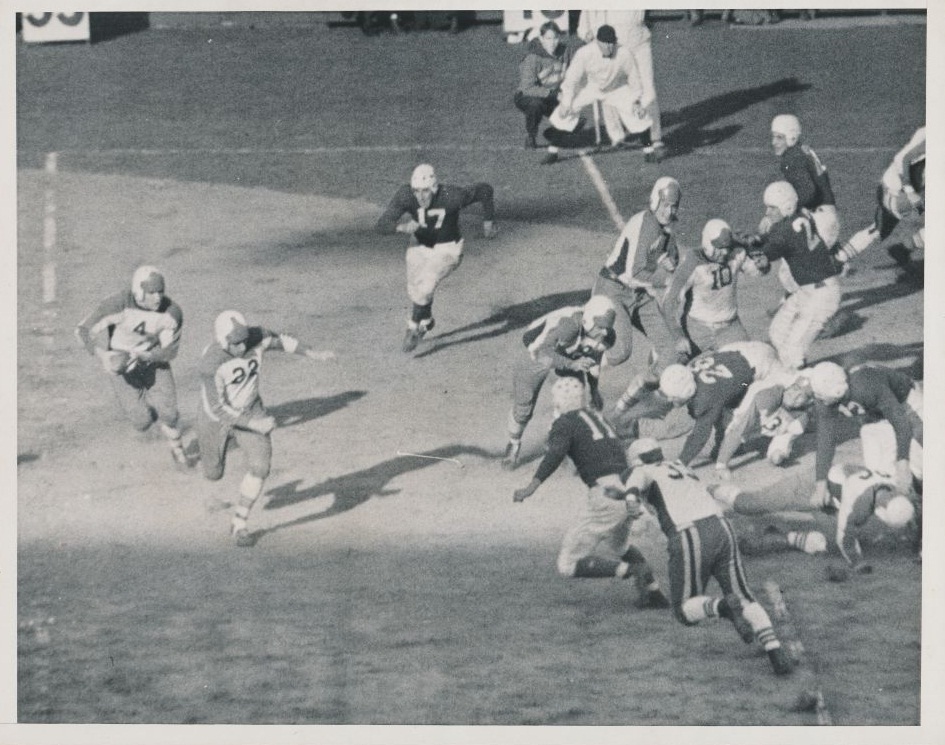
The Giants wore white jerseys with red pants for all their games in 1936.
The red jersey was supplemented by a white one in 1935. It was essentially a negative version of the red jersey: a white body with red sleeve stripes, blue side panels and solid blue block numbers. White socks with red and blue stripes were used with the white jerseys. For 1936, a variation of this with darker blue numbers and side panels became the Giants full-time jersey. New red pants with white and blue stripes down the back made for a very colorful ensemble.
1937 – 1952: Honing in on an Identity
Following 11 seasons of experimentation and discovery, the Giants began to find what would become their signature look. The initial incarnation was displayed at the Polo Grounds for an exhibition match against the Eastern College All-Stars. The helmet was a royal blue shell with a red “Michigan Wing” pattern. The jersey was royal blue with solid white block numbers and the socks were solid royal blue. The pants were a shiny, satin-like material that gave a reflective silver-like appearance. This uniform was worn again for the regular season opener is Washington. After that the silver pants were shelved in favor of tan/beige pants with a matte appearance.
The primary jersey was solid red with solid white block numbers and was worn with solid red socks. This is the uniform the Giants wore in 1938 when they became the first NFL team to win two Championship Games, defeating the Green Bay Packers at the Polo Grounds. The blue jersey and socks combination was worn as an alternate uniform, most often deployed when the Giants opposed a team that also wore red, like the Chicago Cardinals or Washington Redskins.
This uniform set remained mostly unchanged through the next 15 years. One variation was a change in the wing pattern on the helmet. The initial version – worn in 1937 & 1938 – was characterized by two rounded high points on the front bumper, and low wing tips that extend out toward the helmet’s ear holes. The second incarnation of the winged helmet was featured from 1939 through 1947. It was differentiated by the single high point beneath the center stripe, and shorter wing tips that are curved upward toward the crown helmet.
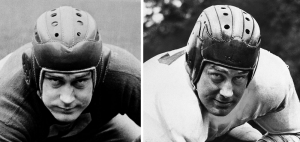
Mel Hein modeling both versions of the Giants’ winged helmets.
Grey pants were worn with the red jerseys beginning in 1940, then both jerseys in 1946.
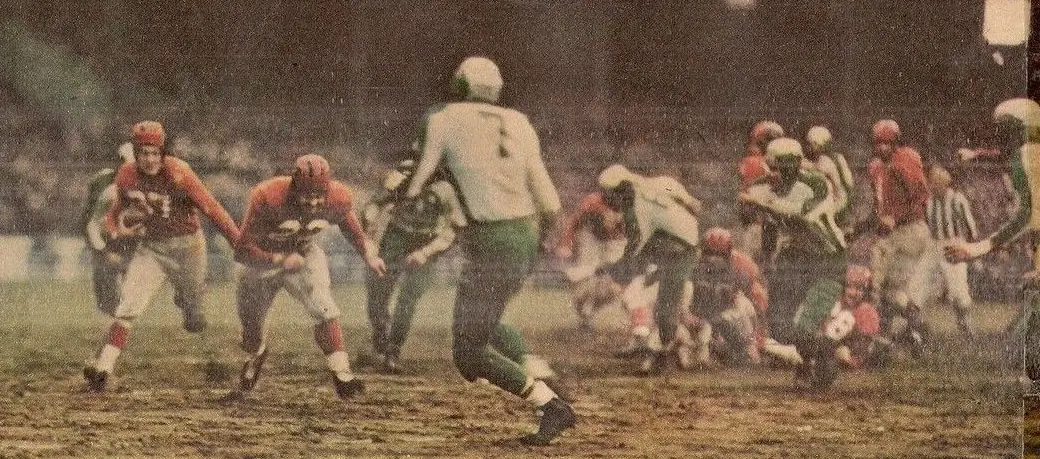
Red was the color customers at the Polo Grounds were most familiar seeing the Giants wearing.
The final leather helmet worn by the Giants appeared in 1948. This model featured a more robust saddle for protect from impacts to the side of the head. The saddle was red and the crown blue with a red cross-pattern.
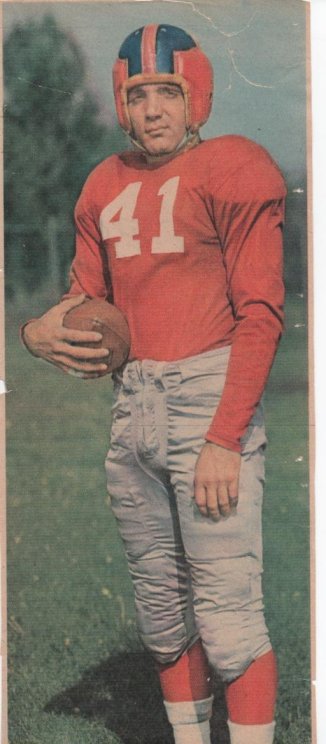
The primary uniform of the 1948 Giants.
As the NFL transitioned from the leather helmet era, the Giants quickly found another significant component of their identity: a solid blue shell (navy blue for many decades) with a single, red stripe down the center.
1953 – 1960: The Classic Era
Television impacted the way teams visually presented themselves on the field to facilitate the viewership following at home on black-and-white screens. More teams instituted the use of a second jersey in their rotation that was white. To accommodate their fans watching at home, the Giants changed their primary jersey in 1953 to blue numbers on white. Although the alternate blue jersey would still appear a few times each season, the Giants were primarily a white-at-home team from 1953 through 1956 (including all home games in 1954).
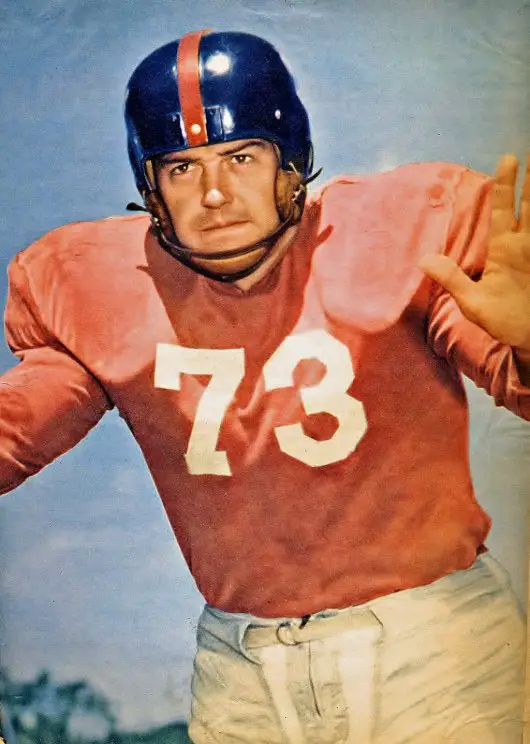
1952 was the final season for the red jerseys as a mainstay.
In 1954 the Giants changed the numbers on the white jersey to red and also added “Northwestern Stripes” to the sleeves. In 1956 the NFL mandated “TV Numbers” to appear on jersey sleeves league-wide, while the Giants also red numbers flanking the red stripe on the back of the helmets. The Giants defeated the Chicago Bears in Yankee Stadium wearing these uniforms for their fourth NFL championship.
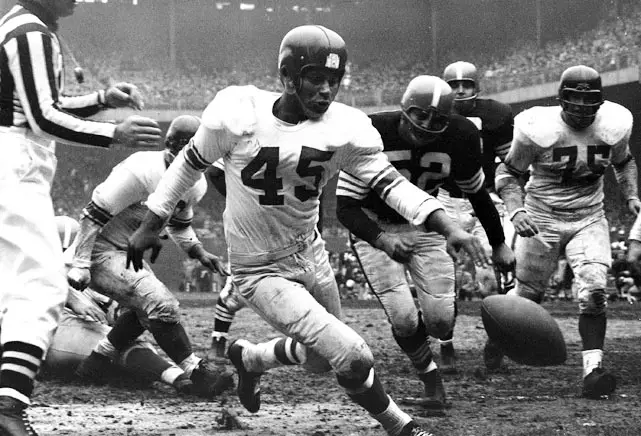
The Giants wore white jerseys for most home games between the years 1953-1956.
The NFL mandated all teams equip their uniform sets with two jerseys in 1957: one a primary color and the second white. The Giants took this opportunity to augment their uniforms with more classic features.
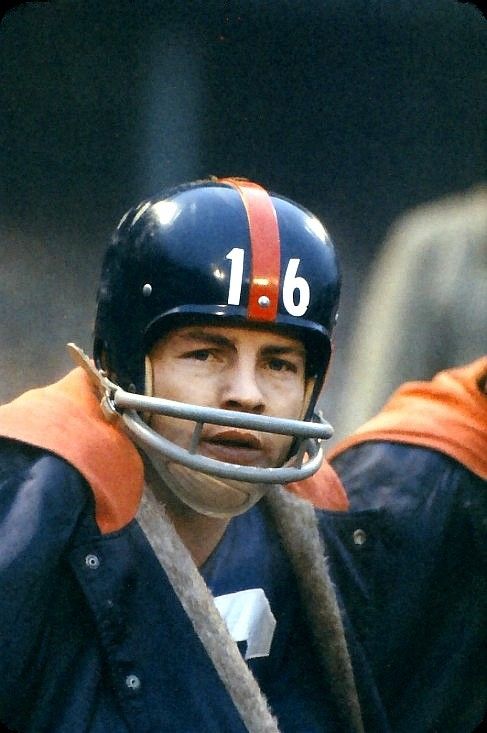
The Giants were the first team to prominently display player numbers on the front of the helmet in 1958.
The helmets now featured bold, white player numbers flanking the red stripe (back only in 1957, then front and back beginning in 1958), and the grey pants featured three thin separated stripes, red – blue – red, down the side. This was also the season the Giants became “Big Blue.” New York (like most NFL teams) wore their primary color jerseys at home full-time over the next 10 seasons, including two famous games in 1958 with Yankee Stadium as their back drop that crystalized their now iconic look: Pat Summerall booting his 49-yard in the snow against the rival Cleveland Browns to force a playoff to decide the Eastern Conference Champion, and two weeks later the Giants heroically bowing to Johnny Unitas’ Baltimore Colts in the NFL’s first sudden-death Championship Game.
1961 – 1965: Continued Refinements
Following the heels of a growing trend, the Giants introduced their first helmet logo in 1961, the lowercase “ny”. Since at least 1948, the Football Giants official logo was a giant sized football player towering over the Manhattan skyline, while they borrowed the varying uppercase, interlocking “NY” logos of the baseball Giants and Yankees for the players and coaches sideline overcoats. Now they had one of their own.
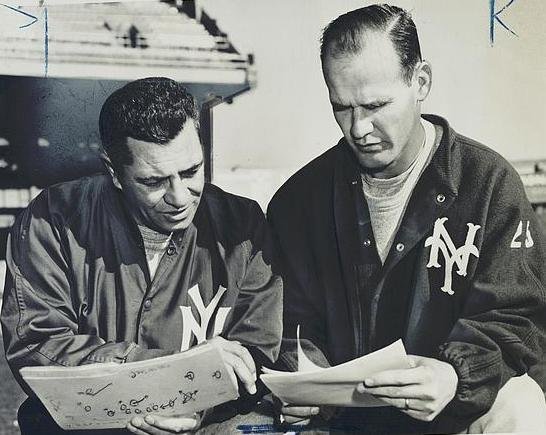
ince Lombardi wearing the Yankees “NY” and Tom Landry wearing the Baseball Giants “NY” in 1958.
The Giants won the NFL Eastern Division the first three seasons with this new logo, as Y.A. Tittle set team and NFL records that would last over 20 years. The pants also had a new stripe pattern, two slightly broader red stripes. In 1962 the pants stripes changed again, three contiguous red-blue-red stripes. The “Northwestern Stripes” were removed from the white jerseys in 1964.
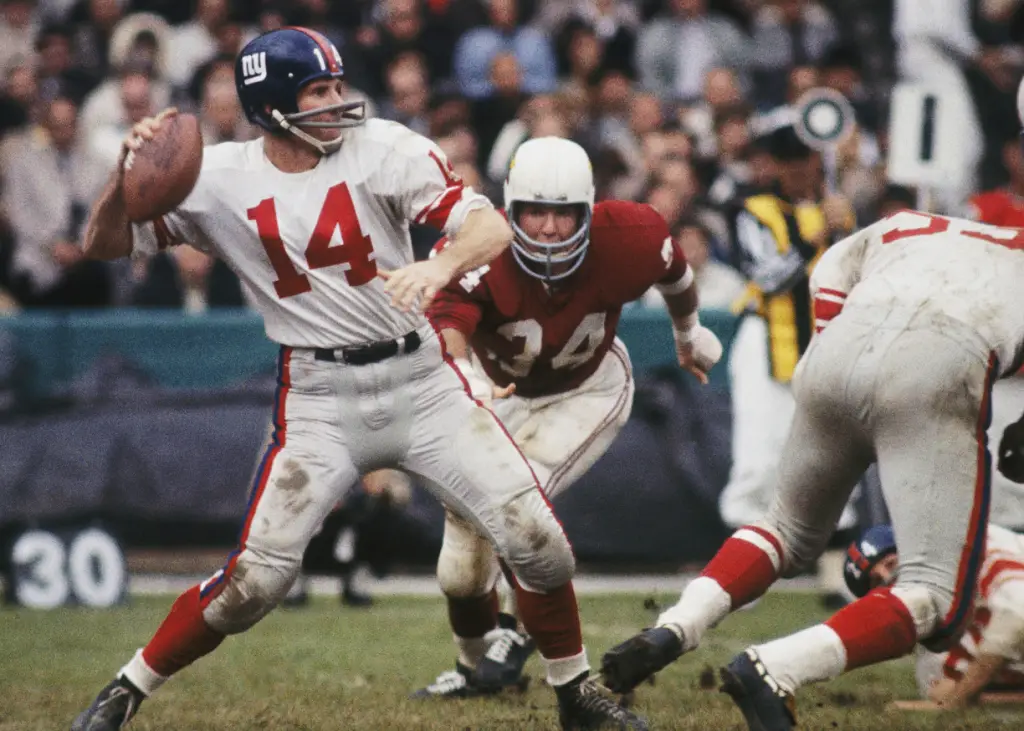
Red remained the prominent accent color on the Giants white uniforms through the 1965 season.
1966 – 1974: Red Takes a Back Seat
The Giants made some significant changes in 1966. The home uniform did not change much. The helmet and blue jersey did not change, but the pants were now white with a reversed blue-red-blue stripe pattern. The away uniform featured white jerseys with blue numbers, the sleeves had a broad blue-red-blue stripe pattern that matched the pants. White socks with that same stripe pattern were worn through 1967, when this was the Giants uniform of choice for home games.
Minor changes for the 1968 season included solid blue socks worn with the white jersey, and the helmet numbers changed to a thinner but much larger font (to the point where the players’ numbers were almost as prominent as the “ny” logo). Along with the rest of the league, the Giants wore “NFL 50” shield patches on their jersey shoulders the shoulders of their jerseys for the 1969 season.
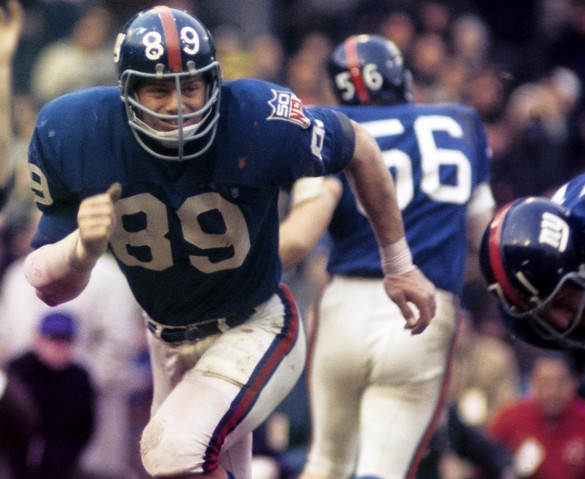
Large helmet numbers, white pants, and the “NFL 50” shield patch were part of the Giants look in 1969.
In the early 1970’s many NFL teams had two jersey sets of jerseys. One was durene, for cold weather games and the other mesh. Often there were differences between the two. For the Giants, the noticeable difference was the sleeve stripes. The durene jersey was unchanged, 3/4 length sleeves with broad stripes, until it was eventually phased out after the 1972 season. The mesh jersey had thinner blue-red-blue stripes at the bottom of the short sleeve and was a permanent away jersey through 1974.
1975 -1979: Stripes and Logos
The Giants appeared to experience a bit of an identity crisis during the mid to late ‘70’s. To say the uniforms were a drastic departure from the norm is an understatement.
In an attempt to appear more modern, the classic “ny” was replaced with a double-line, uppercase “NY”. White stripes bracketed the helmet’s red center stripe, and the player’s numbers were removed from the front of the helmet.
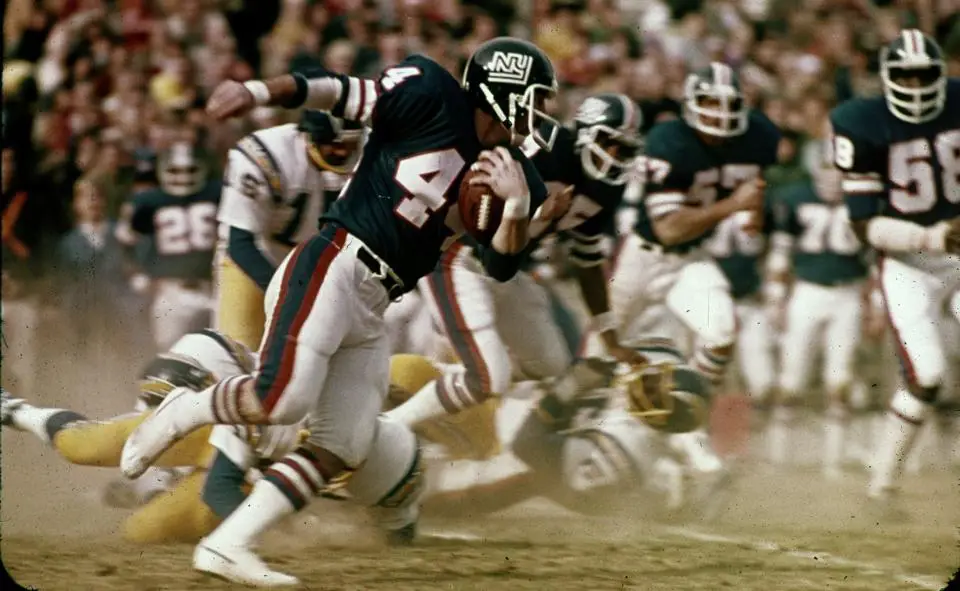
The uniform overhaul of 1975 was a radical departure from the Giants traditional look.
The blue jersey had a five-stripe pattern, two broad white stripes flanked by three thin red stripes, and the white numbers had red trim. The pants had an extra-wide blue stripe that was bordered by two red stripes. The blue socks had a matching stripe pattern as the sleeves for most of the season, until they were replaced late in the season by a white sock with a somewhat inverted blue-red-blue-red-blue pattern.
The white jerseys were a negative version of the blue, and were worn with the Giants first set of blue pants in 40 years. The white socks worn with the blue pants had a set of stripes that matched the sleeves stripes.
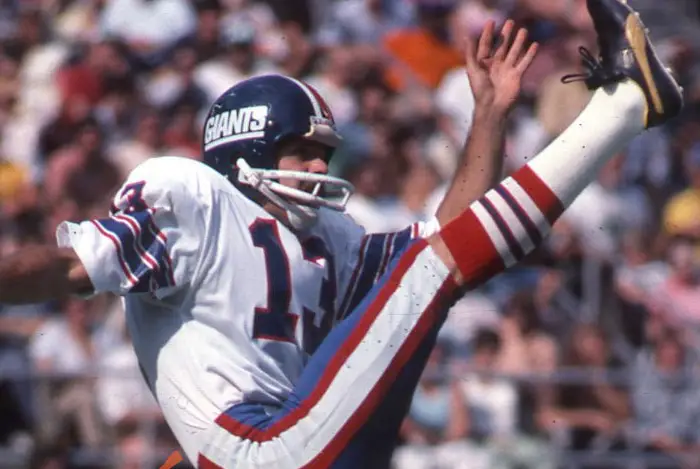
The Giants uniforms of the late ’70’s featured an abundance of stripes.
The “NY” helmet logo was short lived. In 1976, when the team first stepped onto the field at Giants Stadium in East Rutherford, New Jersey, they had another new logo, the italicized and underlined “GIANTS”. It was somewhat reminiscent of the simpler “ny” of the Yankee Stadium era, though the rest of the uniform was not. Some refinements and changes occurred with the socks during the next four seasons. Stripe patterns inverted, white socks were interchanged with red ones (worn with the blue pants only), before blue was settled on permanently in 1977. In 1979 the blue pants were gone and the socks were adorned with an 11-stripe white-red-white pattern.
1980 – 1999: Revision and Stability
Simplicity returned in 1980 as the New York Giants uniforms reflected their early 1970’s look but still retained a modern feel. The white stripes were removed from the helmets and the socks were once again solid blue. The blue jerseys had red-white-red piping along their V-necks and sleeve cuffs. The white pants returned to their familiar blue-red-blue pattern. The blue jerseys had a blue-red-blue pattern. This basic uniform, save for minor number font changes and ceremonial patches, would go unchanged for 20 years. The Giants worn white-at-home for the entire 1980 season, before settling on blue for good, and would wear those blue jerseys as they won Super Bowls XXI and XXV following the 1986 and 1990 seasons.
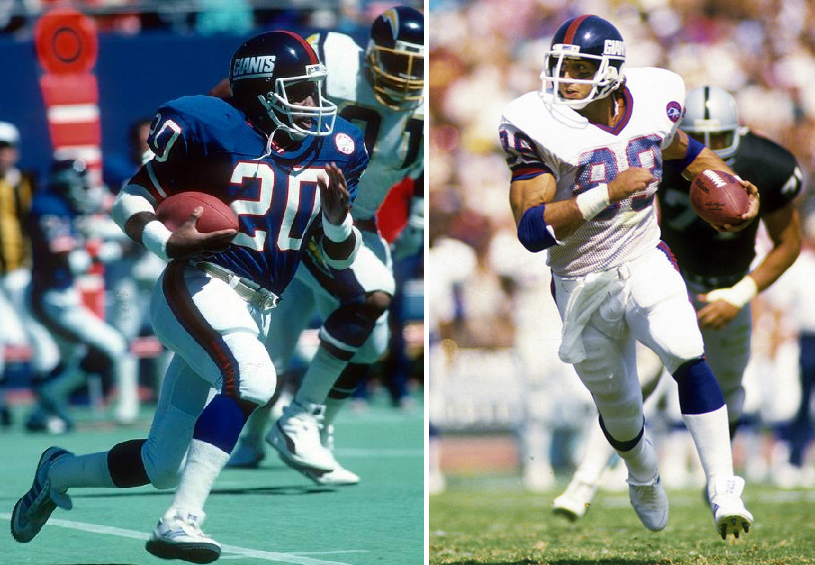
The Giants first full-season memorial patch was the “Spider 43” worn during the championship year of 1986.
Variations occurred that served as memorials – black shoulder stripe was sewn onto the jerseys in 1983 in honor of late RB Coach Bob Ledbetter, and the “Spider 43” patches worn during Lawrence Taylor’s MVP 1986 season (with a white background on the blue jersey and a blue background on the white jersey), or anniversaries – the Super Bowl XXV patch, the “NFL 75” patch in 1994, and the Giants “75th Silver Anniversary” patch in 1999.
The entire NFL wore throwback uniforms in 1994. The Giants chose replicas of their 1962 season, and they were mostly authentically replicated. White pants were used with the blue jerseys instead of the traditional grey, changed at the last moment at the league’s behest.
2000 – 2018: Echoes of the Past
Similar in theme to the previous uniform overhaul, the Giants looked to the past while still maintaining a current feel. A mostly traditional “ny” logo returned to the helmet (it was slightly larger and bolder than the original), as well as the player numbers (now block style matching the jerseys). The matte, navy blue shell was now a metallic royal blue.
The blue jerseys were free of all striping and the numbers were solid white. Given the trend of constantly shortening sleeves, the “TV numbers” moved up to the shoulders. The pants were grey but kept the blue-red-blue stripe pattern. The white jerseys had red numbers again, but now featured blue trim. Solid red socks were worn with the white jersey through 2001, when the Giants added a white “GBY” patch for the late George Young. The Giants wore an “80th Anniversary” patch on the blue jerseys for the 2004 season, and also the new alternate red jersey they would wear once each season the next four years.
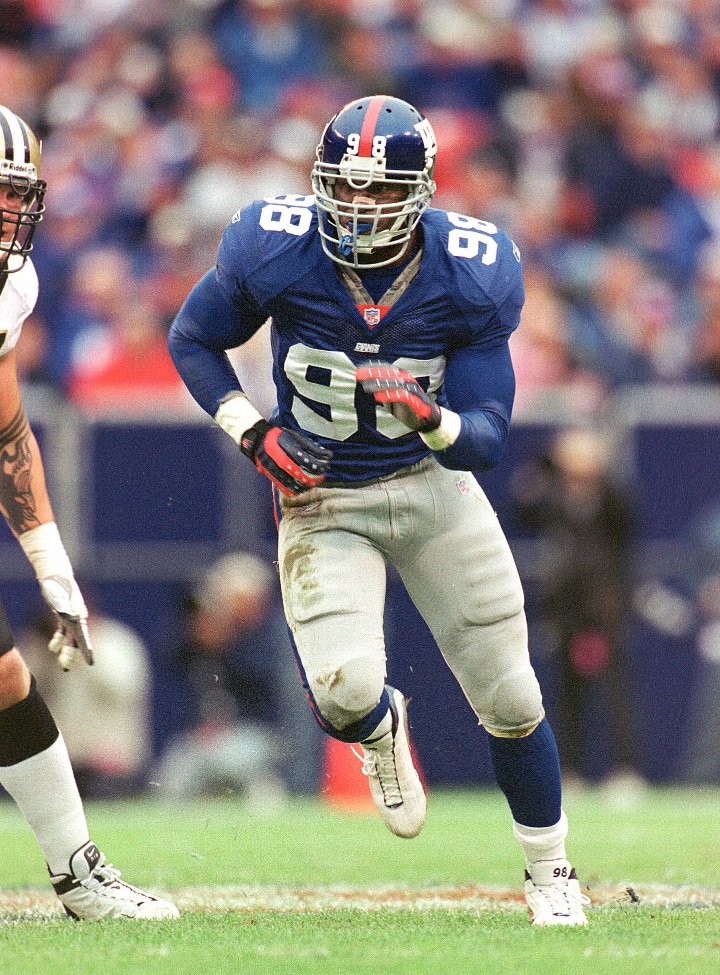
The Giants have featured a classic-but-modern look since 2000.
New retro white jerseys were introduced for the 2005 season. Plain red block numbers were accompanied with “Northwestern Stripes” on the sleeves. Two memorial patches were worn to honor the passing of owners Wellington Mara and Robert Tisch. The grey pants worn with the white jerseys also had the thin, separated red-blue-red stripes last worn in 1960. These are the uniforms the Giants wore when they twice upset the New England Patriots in Super Bowls XLII and XLVI following the 2007 and 2011 seasons.
These pants received a full-time road designation and were also worn with the blue jersey during away games beginning in 2009, before they became the Giants primary pants in 2012. An alternate set of white pants, with an inverted blue-grey-red-grey-blue stripe pattern, was introduced in 2013 and worn occasionally with the blue jerseys at home games before becoming the full-time home pants in 2016. Grey pants were still worn with the blue jerseys for away games. A 90th anniversary patch was displayed on both jerseys in 2014, as well as memorial patches for late owners Ann Mara and Joan Tisch for the 2015 and 2017 seasons respectively.
In response to the league’s mandated mono-toned “Color Rush” program in 2016, the Giants selected an all-white throwback style uniform that was nearly identical to the one worn in the 1980s and 1990s – with the major difference being the absence of the blue socks – and was worn once each season as an alternate.
Grey was officially scrubbed from the Giants uniform palate before the start of the 2021 season, though it remains on the facemasks and as accent striping on the pants with the blue jersey. While the Giants solely wore blue, red and white from 1966 through 1999, their two standard sets now contrast one another visually in a unique fashion that has never been seen before. The white pants worn with the white jersey are augmented by the same red Northwestern stripes that are on the jersey sleeves. With the away all-white uniform being completely devoid of blue (other than the helmet) and the home uniform only sparsely accented with red, the Giants standard uniform set segregates distinctly into nearly all blue-and-white and white-and-red components.
The familiar road uniform with grey pants worn from 2005 through 2020 will appear once as a throwback alternate and the Color Rush uniform twice. The 2021 season will mark the first time the Giants will wear white at home more than once in over 40 years, last occurring in 1980 when they wore white at home the entire campaign.
(To see the Giants uniform history in greater detail, please see the Giants page at the Gridiron Uniform Database.)
